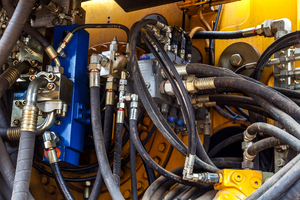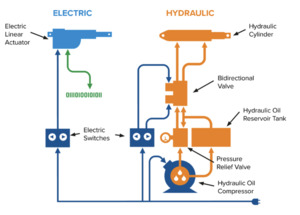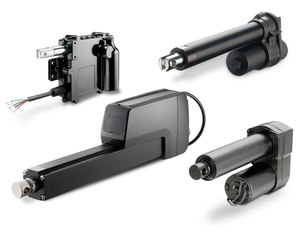
 |
Charlotte Stonestreet
Managing Editor |
| Home> | DRIVES & MOTORS | >Linear Actuators | >Achieving hazard-free linear motion |
| Home> | POWER TRANSMISSION | >Linear | >Achieving hazard-free linear motion |
| Home> | MACHINE BUILDING & ENGINEERING | >Machinery Safety | >Achieving hazard-free linear motion |
Achieving hazard-free linear motion
16 June 2025
Chris Diak and Robert Johansson make the safety case for electromechanical actuators over hydraulic cylinders

LINEAR MOTION machine designers increasingly specify electromechanical actuators because they are cleaner, easier to control, and require less maintenance than hydraulic cylinders. However, the intrinsic safety benefits of using electromechanical solutions are often overlooked. These are derived from eliminating the need for hydraulic fluid and implementing an all-electric load-handling solution.
Design engineers specify hydraulic cylinders for their high-strength, high-cycle operation, but achieving this requires an intricate external system of hoses, connectors, filters, switches, valves and pumps. Even a low-pressure hydraulic system (150–350 bar) could have at least eight separate moving parts, but some can be pressurised up to 750 bar and heated to 80°C. These factors, combined with the inherent characteristics of hydraulic oil, can result in any of the following problems:
- Physical trauma: High-temperature, high-pressure systems present potential risk even in routine operation, but the chance of danger increases as these wear and components fail. Proximity to hydraulic lines can result in burns, bruises, cuts or abrasions.
- Exposure risk: The U.S. Agency for Toxic Substances and Disease Registry reports that some hydraulic fluids can irritate skin or eyes and that ingesting certain types can cause pneumonia, intestinal bleeding or death in humans. The effects of breathing air with high levels of hydraulic fluids are unknown, but some countries have set hydraulic fluid exposure limits. The National Institute for Occupational Safety and Health (NIOSH) recommends an exposure limit of 350 mg/m3 of petroleum distillates for an 8-hour workday and a 40-hour workweek.
- Contamination: Hydraulic fluids can harm the environment and are potentially toxic to humans. Both new and waste oil need special handling.
- Slip and fall hazards: There is a clear risk of workers being injured when slipping on puddles of leaked fluid or falling while climbing up their machines with oil on their hands or shoes.
- Cleanup: Indoor spills may be subject to local regulation or require additional investment in absorbent substances or other cleanup services.
Combustibility. Petroleum-based hydraulic fluids are less flammable than petroleum middle distillate fuels such as jet fuel, kerosene or diesel fuel. However, these can be a fire hazard if sprayed, as might happen when high-pressure leaks convert the fluid to an aerosol state.
Because hydraulic fluids degrade and lose effectiveness over time, they must be replaced regularly, resulting in additional costs to maintain an inventory of new oil and filters. Typically, additional maintenance department resources are needed to check filters and oil integrity to determine when to change the fluids. Laxity in any of these efforts increases the risk of using hydraulic fluids.
The safe choice
Despite such disadvantages, hydraulic designs have been implemented because they were the best alternative for heavy-duty, high-cycle actuation. Hydraulic applications have traditionally handled heavier force and loads in applications for less initial investment. Electromechanical actuators have advanced to handle heavier loads, actuator synchronisation and simple implementation—all without hydraulic fluids or intricate plumbing— delivering comparable or better performance than hydraulic systems.

Figure 2 above compares the operation of electric actuators and hydraulic cylinders. Electromechanical actuators embed all operating functionality in the actuator housing, which connects an electronic control unit (ECU) with only a few wires.Microprocessors enable this capability and can be programmed to report position, provide diagnostic feedback to improve performance, and handle complex functions like synchronising multiple actuators. Besides eliminating the hazards directly related to using fluids, electromechanical actuators deliver the following plant safety benefits:
- Operators gain maximum control over the load by being enabled to ramp up speed, slow it down, follow a consistent motion profile or hold a position.
- Compact housings are easier to seal, thus eliminating contamination risks.
- Fewer moving parts means less wear and tear and a lower risk of failure.
- Implementing and operating performance monitoring is much easier because most is accomplished with software rather than external systems.
- Electronic actuators can accept commands and, in return, provide safety-related data such as load or temperature.
- Operations can be shut down easily in case of an incident.
- Electronic systems can be overridden manually if necessary.
- Operation is silent, removing the danger of hearing impairment from constant exposure.
As workplace safety awareness grows among government regulators and the general public, it has becomean important consideration when designing a green motion control solution. Electromechanical actuators address some of the safety disadvantages of hydraulic-cylinder-based systems. Combine this with their ease of operation and maintenance, and you have an ideal option for your actuator needs in the future.
Chris Diak is automation product sales manager at Motion; Robert Johansson is industry manager senior of linear actuators at Thomson Industries
- Design tradeoffs
- Designing smart machines starts with smart tools that enhance automation control
- Upwardly mobile
- Thomson introduces first collaborative 7th axis with collision detection
- Bridging the performance gap
- Motor integration simplified
- Upgraded sizing & selection tool for linear motion systems
- Anti-rotational guidance for stepper motor linear actuators
- LIVE WEBINAR: Sizing & selecting ball screw drives for standard & custom applications
- Size & select electric linear actuators online





















